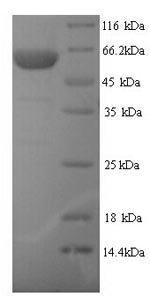Recombinant human E3 ubiquitin-protein ligase TRIM21 production in yeast involves co-cloning the gene of interest (1-475aa of human TRIM21) into an expression vector with an N-terminal 6xHis-tag gene, followed by transformation into yeast cells. The cells are cultured under conditions that induce protein expression. After sufficient growth is achieved, the cells are lysed to release the recombinant TRIM21 protein, which is purified through affinity chromatography. The purity of the protein is confirmed using SDS-PAGE, exceeding 90%.
RIM21, also known as Ro52/SSA1, is an E3 ubiquitin ligase particularly involved in immune host defense, signal transduction, and immune responses. TRIM21 participates in innate immunity by regulating the ubiquitination of IFN regulatory factors (IRFs) [1]. It negatively regulates the innate immune response to intracellular double-stranded DNA by promoting the degradation of DDX41 [2]. Additionally, TRIM21 interacts with proteins such as endoglin and galectin-3, indicating its role in modulating inflammatory responses [3]. TRIM21 is associated with NF-κB-dependent cytokine expression, emphasizing its importance in regulating inflammatory processes [4]. Furthermore, TRIM21 also contributes to cancer development. Studies have reported that TRIM21 promotes hepatocarcinogenesis by inhibiting the p62-Keap1-Nrf2 antioxidant pathway [5].
References:
[1] M. Sjöstrand, A. Ambrosi, S. Brauner, J. Sullivan, S. Malin, V. Kuchrooet al., Expression of the immune regulator tripartite-motif 21 is controlled by ifn regulatory factors, The Journal of Immunology, vol. 191, no. 7, p. 3753-3763, 2013. https://doi.org/10.4049/jimmunol.1202341
[2] Z. Zhang, M. Bao, N. Lü, L. Weng, B. Yuan, & Y. Liu, The e3 ubiquitin ligase trim21 negatively regulates the innate immune response to intracellular double-stranded dna, Nature Immunology, vol. 14, no. 2, p. 172-178, 2012. https://doi.org/10.1038/ni.2492
https://doi.org/10.3389/fimmu.2017.00780
[3] E. Gallardo-Vara, L. Ruíz-Llorente, J. Casado‐Vela, M. Ruiz-Rodríguez, N. López‐Andrés, A. Pattnaiket al., Endoglin protein interactome profiling identifies trim21 and galectin-3 as new binding partners, Cells, vol. 8, no. 9, p. 1082, 2019. https://doi.org/10.3390/cells8091082
[4] R. Yoshimi, T. Chang, H. Wang, T. Atsumi, H. Morse, & K. Ozato, Gene disruption study reveals a nonredundant role for trim21/ro52 in nf-κb-dependent cytokine expression in fibroblasts, The Journal of Immunology, vol. 182, no. 12, p. 7527-7538, 2009. https://doi.org/10.4049/jimmunol.0804121
[5] F. Wang, Y. Zhang, J. Shen, B. Yang, W. Dai, J. Yanet al., The ubiquitin e3 ligase trim21 promotes hepatocarcinogenesis by suppressing the p62-keap1-nrf2 antioxidant pathway, Cellular and Molecular Gastroenterology and Hepatology, vol. 11, no. 5, p. 1369-1385, 2021. https://doi.org/10.1016/j.jcmgh.2021.01.007






